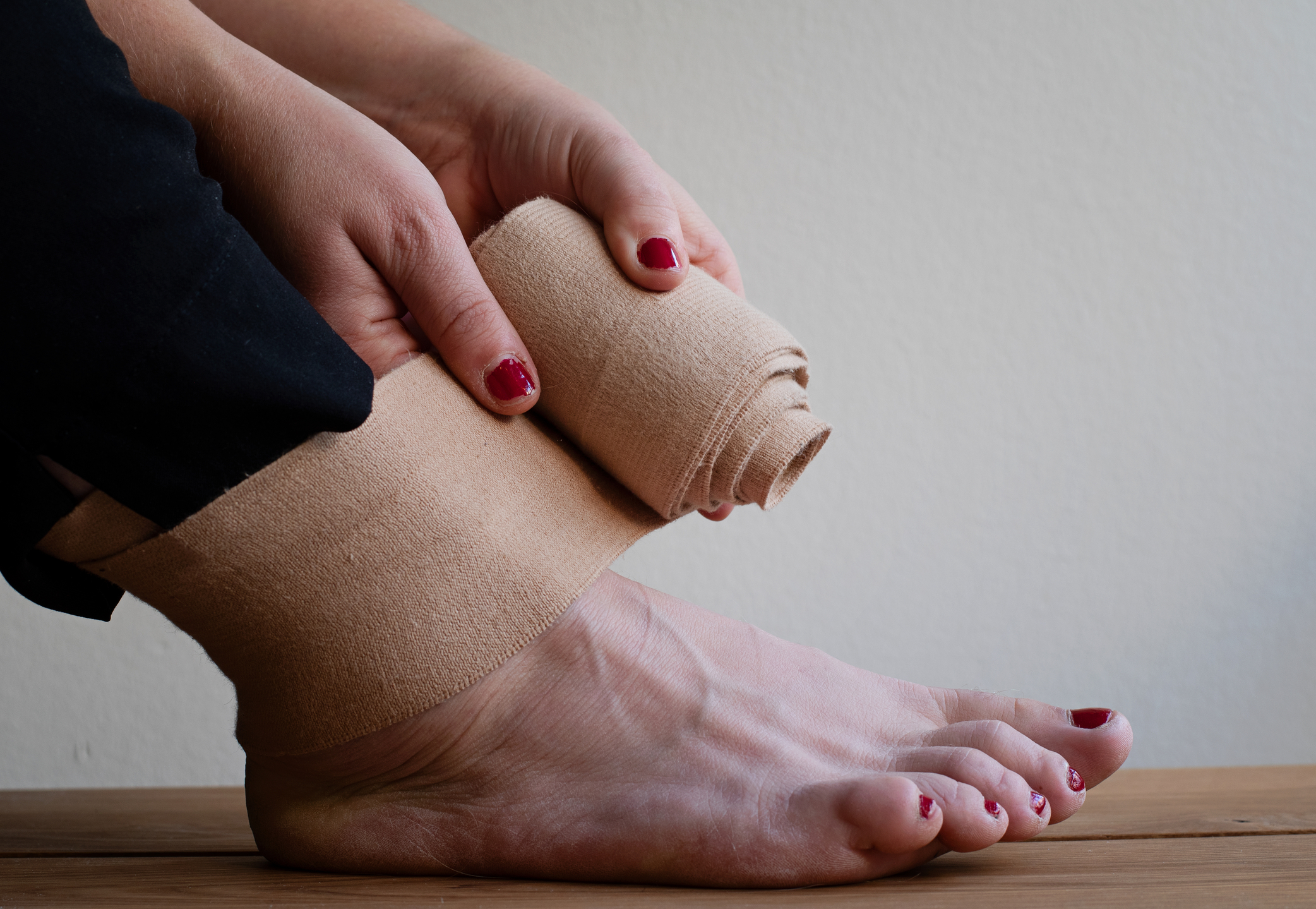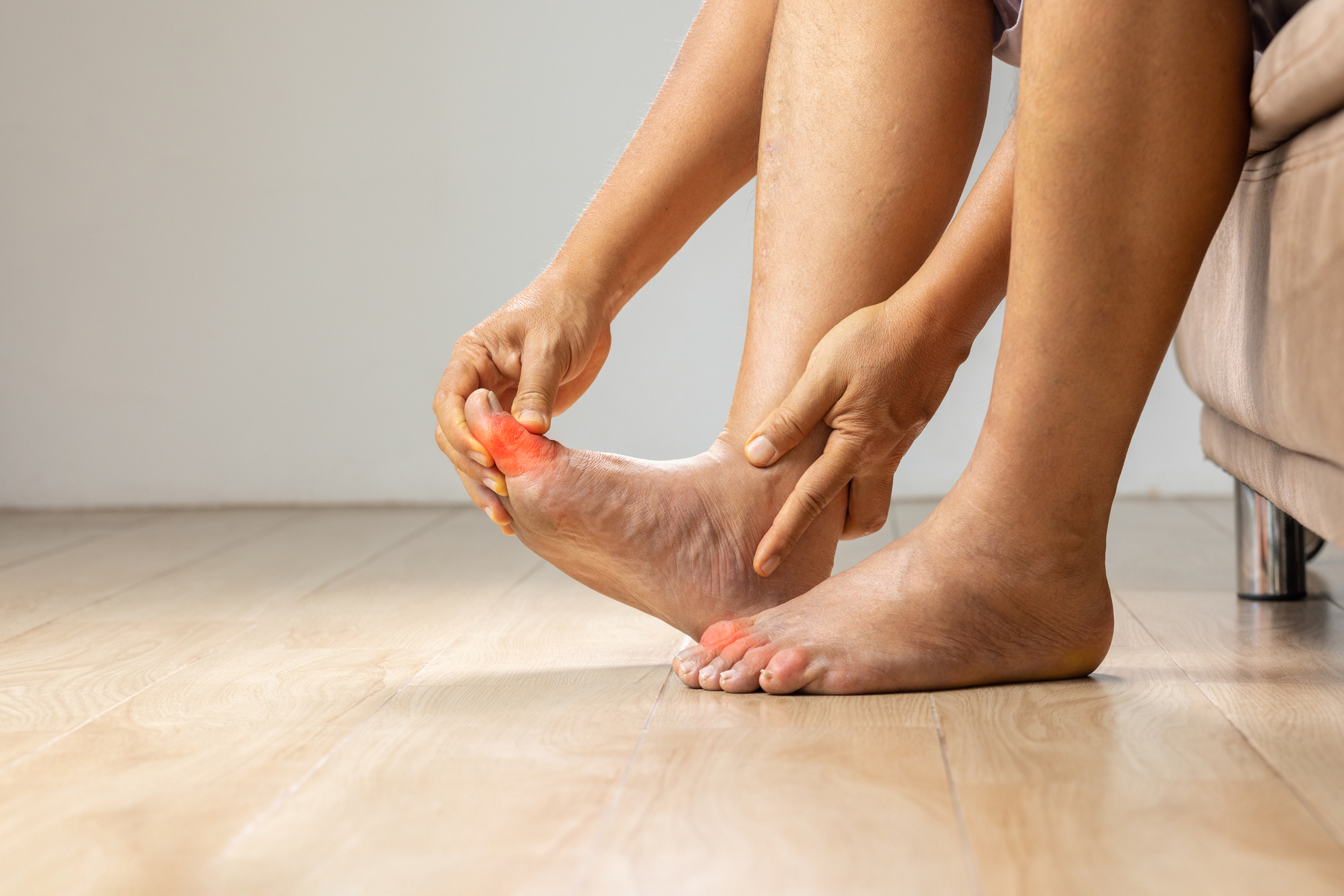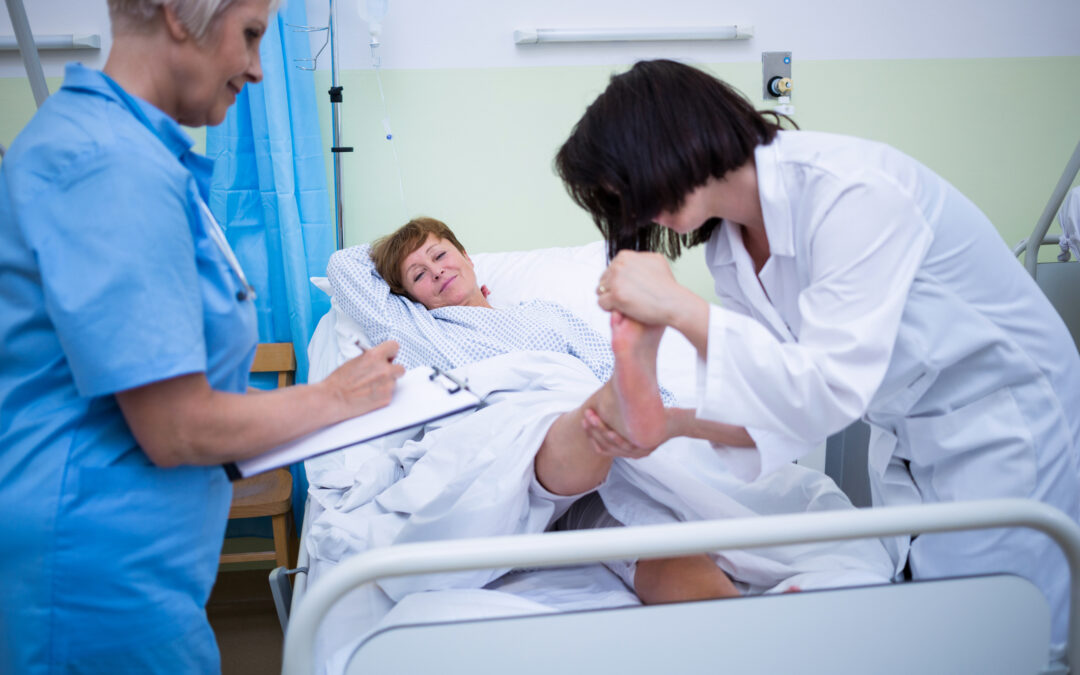While swollen feet caused by prolonged periods of standing or walking can be highly uncomfortable, it can be an indication of a potentially serious condition in elderly. Here are the causes of swollen feet in elderly.
Many seniors struggle with swollen feet and ankles, particularly in the evening. You might be wondering why this irksome condition keeps bothering you. While anyone can struggle with swollen feet sometimes, it can be treated by resting or elevating those tired dogs.

swollen ankles and feet in elderlry
Swollen feet and ankles in elderly are common and usually occur after prolonged periods of standing or walking. However, more frequent swollen feet in elderly, accompanied by other symptoms, could indicate a severe health complications.
For instance, swollen feet and ankles in elderly (edema) could be a red flag for underlying severe problems, such as blood clots in the legs, heart failure, kidney disease, etc.
Let’s discuss the cause of swollen feet in elderly, as well as symptoms and treatments for swollen feet and ankles in elderly.
Contents
Causes of Swollen Feet in Elderly
A few possible causes of swollen feet and ankles in elderly include:
1. Chronic Venous Insufficiency (CVI)
Chronic venous insufficiency (CVI) is a venous disease that damages the veins of the legs. As a result, veins responsible for supplying blood from the heart to the feet and back don’t function as well as they should. The disease caused blood flow to pool in the leg veins, causing high blood pressure in the affected veins.
While symptoms of CVI may be mild, the condition can cause swollen feet in elderly while also affecting their quality of life, leading to serious health complications. For instance, when left untreated, the elderly with CVI risk developing foot ulcers, phlebitis, etc.

Swollen feet in elderly
Moreover, common causes of developing CVI include being overweight, pregnancy, family history of the problem, an injury, surgery, and blood clots to the feet. However, a few other causes of swollen feet and ankles in elderly may also occur due to high blood pressure in the leg veins due to prolonged sitting or standing.
Additionally, lack of exercise, tobacco, blood clots in deep veins, and swelling and inflammation of veins close to the legs can also cause swollen feet in elderly.
Symptoms
A few possible symptoms of chronic venous insufficiency may include:
- Itchy, painful legs or tight feeling in the calves.
- Swelling feet and ankles in elderly.
- Pain when walking that discontinues upon resting.
- Discolored skin near the ankles.
- Untreated leg ulcers.
- Leg cramps or muscle spasms.
Prevention
There are a few ways that you can try to prevent or reduce CVI symptoms in elderly. It includes:
- Improved blood flow in the leg veins can prevent the development of CVI. In this regard, techniques like keeping your legs raised (elevated) for some time daily can reduce the cause of swollen feet elderly. Moreover, compression stockings are also great for improving blood flow.
- Certain medicines that help improve blood flow through the vessels accompanied by compression therapy may help.
- Avoid sitting or standing for prolonged periods, especially if you have CVI symptoms. Instead, get up and move around.
- Maintain a healthy diet and body weight.
- Avoid smoking and exercise regularly.
2. Injured Foot or Ankle
An injury to the foot is another common cause of swollen feet in elderly. However, spraining is the most common injury type that could cause swollen feet and ankles. It occurs due to an injury or misstep, causing ligaments (that hold the ankle in place) to be overextended from their normal range.
A few conditions that can cause foot or ankle injury inflammation include:
- Ankle sprain.
- Broken bones.
- Broken leg.
- C.L. tear.
- Knee sprain.
If you or an elderly family member suffers from swollen feet due to a foot or ankle injury, the R.I.C.E. technique is an effective way to treat the condition. R.I.C.E. technique involves:
- Resting the injured limb and escaping locating pressure on it.
- Icing the affected foot for half an hour at a time daily.
- Compression bandage to help prevent or reduce swelling.
- Elevation means keeping your affected feet lifted above your heart when resting, especially at night.
While keeping your injured foot or ankle at rest is essential, too much rest can lead to complications, such as poor foot circulation. So, it is necessary to consult your podiatrist and check the appropriate amount of activity for your feet or ankle.
Moreover, depending on the severity, your doctor may prescribe you an over-the-counter pain reliever. Additionally, wearing a brace or splint may also help ease the condition.
Prevention
A few helpful tips for preventing swollen feet and ankles in elderly due to an injury include:
- Avoid putting weight on the affected leg.
- Elevate the affected leg when possible.
- Wear a compression bandage or use an ice pack to reduce swelling.
3. Lymphatic Dysfunction (Lymphedema)
Lymphedema or lymphatic dysfunction is another common cause of swollen feet in elderly. For people with lymphatic dysfunction means their lymphatic system is damaged and not functioning well. This system consists of lymph vessels and lymph nodes responsible for draining fluids from the body tissues.

elderly feet care
These fluids transmit toxins, waste products, and immune cells to the lymph nodes. Similarly, lymph vessels maintain fluid balance in your body by returning filtered fluid to the bloodstream. Since a weak lymphatic system causes swollen tissues, resulting in swollen feet and ankles in elderly.
Lymphedema can be a result of various complex genetic implications or can occur due to a disease complication.
Symptoms
One of the significant signs of lymphedema is swelling in your arms, legs, or feet. Your toes, fingers, head, or neck tissues may also retain fluid and swell. This swelling could significantly limit your range of motion, and you may feel heaviness or an ache in the affected part. Other symptoms of lymphatic dysfunction that could cause swollen feet in elderly include:
- Swelling in legs, feet, or toes.
- Restricted motion range.
- Feeling tightness or heaviness in the affected part.
- Recurring infections.
- Thickening or hardening of the affected area.
Prevention
A few helpful techniques to prevent swollen feet and ankles in elderly include:
- Using compression therapy is an effective way to treat lymphedema. It involves compressing the affected limb to move fluids toward the torso and out of the leg in a regular pattern. Additionally, a firm wrapping of elastic bandage on your leg or arm can keep continuous pressure on the affected limb. It will help you reduce swelling, decrease stress, and improve mobility.
- Regular exercise is another way to treat or prevent lymphatic dysfunction. It helps your muscles contract; these contractions add pressure on your lymph vessels to move fluid through and reduce swelling.
- If you or an elderly family member suffers from lymphedema caused by a bacterial infection, certain antibiotics can help reduce pain and swelling. Moreover, they also help eliminate the risk of the infection spreading.
4. Feet or Ankle Infection
If you or an elderly family member in your home experience swelling in the ankles or feet, it can be a sign of infection. Especially those with nerve problems or diabetic neuropathy are more prone to the risk of developing foot infections.
Moreover, if you have diabetes, keeping a close eye on your feet and looking for sore, blisters, and cuts is essential. Remember that nerve damage can dull the pain sensation, making foot implications progress quickly. Additionally, if you see blisters or swollen feet and ankles that appear to be infected, seek the immediate help of your podiatrist.
Symptoms
A few common symptoms of swollen feet and ankles in elderly caused by foot infection include:
- Discolored foot skin.
- Swelling and pain.
- Open wounds that heal slowly.
- Feet inflammation.
- Breaks or dryness of feet skin.
Prevention
- Keep your feet dry and clean, particularly between the toes. If your feet get sweaty, change footwear and socks more frequently. Moreover, wear socks made of cotton, wool, or other moisture-wicking material.
- Protect your feet in public places, like locker rooms or showers. Additionally, wear waterproof footwear to protect your feet from moisture.
- Apply moisturizers or antifungal powders on the feet daily.
5. Blood Clots
The creation of blood clots in the legs is another common cause of swollen feet in elderly. They affect the blood flow in the veins of the legs, preventing it from reaching the feet and then back to the heart by causing blood clots. These blood clots cause swollen feet and ankles in elderly, limiting their mobility.
Additionally, blood clots in the veins can either be superficial (blood clots in the veins beneath the skin) or deep (deep vein thrombosis). While deep veins condition essentially blocks significant veins of the legs, the effects can be fatal and life-threatening, causing heart or lung diseases.
Moreover, if you or one of your elderly family members is experiencing swelling in the feet or ankles that causes pain, mild fever, or changes the color of the affected part, ensure to consult your podiatrist immediately. They may suggest blood thinners treatment.
Symptoms
Common symptoms of swollen feet in elderly due to blood clots include:
- Cramping or throbbing pain in one leg.
- Warm skin around the affected part.
- Swelling in one leg.
- Discolored skin around the affected body part.
- Swollen veins that feel hard or sore when you touch.
Prevention
- One of the effective ways to prevent superficial or deep vein blood clots is to quit smoking. It also enhances the blood flow in the body.
- If you or an elderly family member has had surgery, try to move as soon as possible. Moreover, avoid crossing your legs while sitting, as it can interrupt the blood circulation in the legs.
- When traveling for more extended periods, try to take frequent breaks and stretch your legs, especially if you are experiencing ankle or foot swelling. For instance, during air travel, stand and walk more frequently. Similarly, stop your vehicle every hour and walk around
- if you are traveling by road.
- If you cannot walk, doing lower leg exercises can help enhance blood flow. For example, you can raise and lower the heels while keeping the toes grounded. Similarly, raise your toes while keeping the heels grounded.
- The elderly with obesity are more at risk of developing deep vein thrombosis. So, regular exercise is essential to prevent blood clots for reducing the risk of swollen feet and ankles in elderly. In this regard, mild physical activity of up to 30 minutes daily will improve blood circulation.
- Maintain a healthy weight.
6. Heart, Liver, or Kidney Problems
Sometimes, swollen feet in elderly can also result from heart or kidney-related disease. Feet or ankles that swell, particularly in the evening, could be a red flag of absorbing excessive salt and water. A kidney-related illness can also trigger swollen feet and ankles in elderly. For instance, when your kidneys stop functioning properly, fluid builds up in the body.
Similarly, the liver disease affects the production of a type of protein known as albumin, which is responsible for preventing the leakage of the blood out of the vessels into the surrounding tissues. In such cases, insufficient albumin production can cause fluid leakage.
That said, if you or an elderly member in your family is experiencing feet or ankle swelling accompanied by other symptoms like loss of appetite, fatigue, or weight gain, see your podiatrist immediately.
Symptoms
- Swelling in lower legs.
- Narrowed blood vessels.
- Pain, achiness, bumping, or fatigue in foot muscles.
- Numbness of the legs.
Prevention
- Maintaining a healthy diet with less salt can help prevent swollen feet and ankles in elderly due to heart disease. Avoid consuming high sodium foods, such as prepackaged, processed, or fried foods. However, since the human body needs sodium, do not try to eliminate it.
- Increasing or maintaining physical exercise levels where possible can reduce the risk of developing heart-related swelling in the feet. However, consult with your podiatrist to create a healthy exercise routine.
- Managing stress is another essential tip to preventing swollen feet in elderly. You can try stress management techniques like meditating, journaling, or going to therapy. Remember that situation can worsen for people with heart disease during an emotional crisis.
- Take frequent breaks and elevate your feet whenever possible.
7. Foot Tendonitis
Foot tendonitis is a disease responsible for causing irritation or inflammation in the feet. Tendons are solid bands of body tissues that attach muscles to the bones. Foot tendonitis is also a significant cause of swollen feet in elderly and could result from overuse or ankle or foot injury.

elderly feet care
Since human feet have many tendons, tendonitis can damage any of them. However, some common tendonitis includes:
- Achilles: This tendonitis damages the tendon responsible for attaching calf muscles and the heel bone. Remember that Achilles is also the strongest muscle in the human body, as they help us walk, run, jump, and perform other activities.
- Extensor: If you or an elderly family member is experiencing tendon irritation running along the top of the foot, they may suffer from extensor tendonitis. These tendons are responsible for connecting front leg bones to the toes.
- Plantar Fasciitis: If you experience pain and swelling underside of the heel and within the foot arch, it might be due to plant fasciitis. While plantar fasciitis is not technically a tendon, it can produce painful conditions that tendonitis cause.
Moreover, while anyone can experience foot tendonitis, they are more concerned about the elderly who overuse tendons. Furthermore, people who cannot maintain a healthy weight are also more prone to foot tendonitis.
Symptoms
A few common symptoms of foot tendonitis that cause swollen feet in elderly include:
- Bone spurs.
- Thickening of the tendon.
- Pain or irrigation along the tendon or where it attaches to the bone.
- Stiffness in the tendon.
- Redness, swelling, or warmth around the affected part.
Prevention
You can reduce the risk of developing foot tendonitis by following a few preventing measures:
- Avoid pushing through pain; instead, let pain be your guide.
- Maintain a healthy diet and body weight.
- Take frequent breaks between workouts.
- Gradually work up to intense physical activities.
- Wear proper footwear that should fit snugly.
Has Your Senior Parent Had Problems with Swollen Feet?
That is all about causing edema or foot swelling in the elderly. While a little ankle or foot swelling is not much concerning, you should still call your podiatrist before developing severe health complications, especially if you are elderly. We hope this post will help you keep your feet healthy and prevent creating swollen feet and ankles in the elderly.
We hope this article was helpful in giving you a better understanding of foot swelling and some tips on how to prevent and manage swollen feet in elderly parents. Please leave your comments and questions below; we would love to hear from you!
You Might Also Like:





